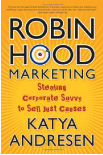Benjamin Franklin famously said that you will catch more flies with honey than with vinegar. In Trust Agents, Chris Brogan and Julien Smith update Franklin for the digital age.
You can’t force anyone to pay attention to your message. These days, there are just too many other things they could be doing. Even on broadcast TV, people changed channels to get away from ads. Now, there are more “channels” than ever, and many of them are online. People won’t listen to you unless you give them a reason to: namely, that they trust you.
Here are some of the ways to behave to win people’s trust, especially online.
Hang out with them. In social media, for instance, find out where the people you’re interested in meeting congregate and spend time there. Even better, if you can: create a meeting place where they’ll want to spend time.
Listen. Don’t rush in and blurt out a sales pitch. Take time to find out who’s “in the room” with you. Learn what they like, and how they talk and don’t talk. Give them time to feel you’re one of them.
Be helpful. Share information, provide tips, make referrals, help solve problems. Don’t count favors provided versus favors owed. Cast your bread upon the waters, as the Bible says, and it shall return to you in many days.
Rely on relationships. Use what you have that’s valuable to others to make them more interested in sharing what they have that would be valuable to you.
Build social capital. Put yourself at the center of relationships and whole networks that make everybody stronger.
This book was published in 2009, and many of us have gotten the message since then. If you are still wondering how to make “this social media thing” work for you, then this is the book to read. If you know the how-to, this book will remind you of the reason why.
I have to say, the book nearly lost me in chapter 2, where the framework is all drawn from games and hacking. It seems there’s a fine line between using social media and using people, and this part of the book made me feel I was on the wrong side of the line. If you have the same reaction, skip that chapter and read the rest. It will be worth your while, whether you’re trying to build a career, a business, or a nonprofit organization. In fact, I will blog soon about how nonprofits are better positioned to win trust than businesses. Stay tuned!


